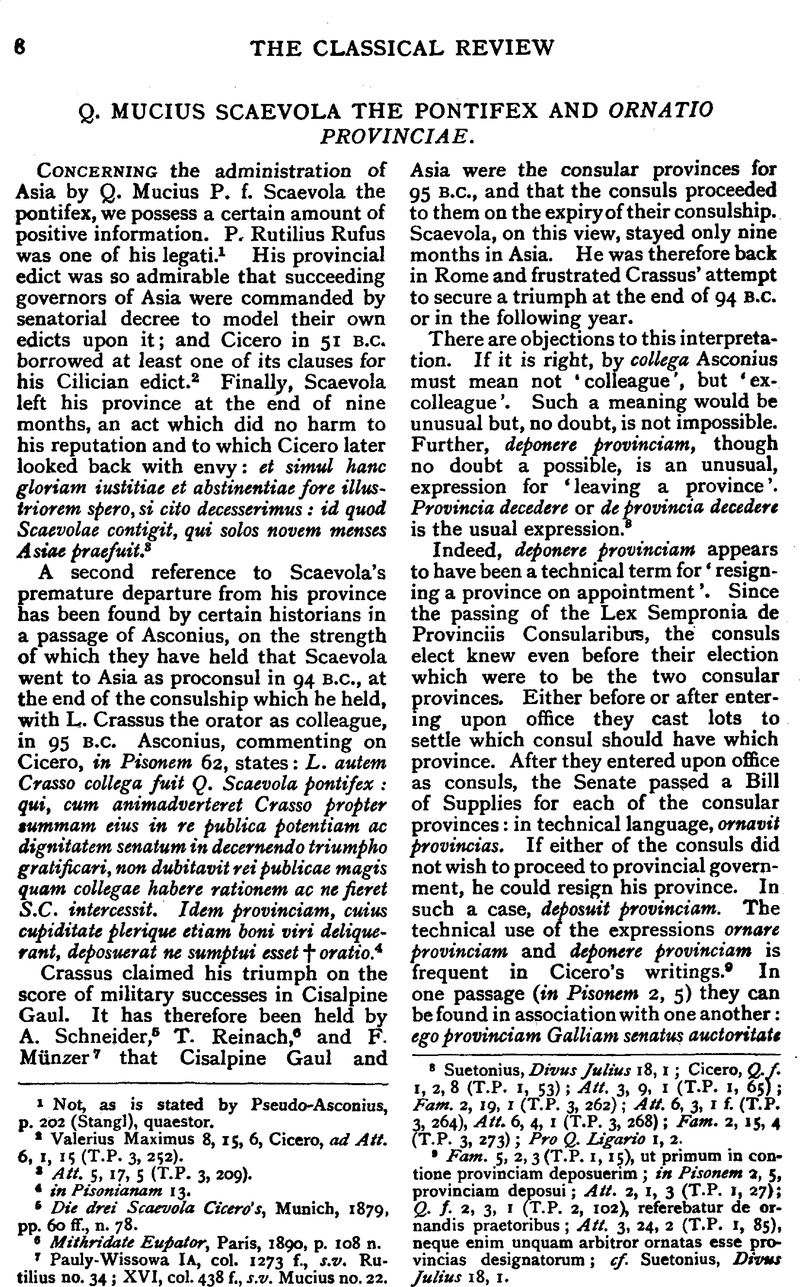No CrossRef data available.
Article contents
Q. Mucius Scaevola the Pontifex and Ornatio Provinciae
Published online by Cambridge University Press: 27 October 2009
Abstract

- Type
- Review Article
- Information
- Copyright
- Copyright © The Classical Association 1937
References
page 8 note 1 Not, as is stated by Pseudo-Asconius, p. 202 (Stangl), quaestor.
page 8 note 2 Valerius Maximus 8, 15, 6, Cicero, ad Att. 6, 1, i5(T.P. 3, 252).
page 8 note 3 Att. 5, 17, 5 (T.P. 3, 209).
page 8 note 4 in Pisonianam 13.
page 8 note 5 Die drei Scaevola Cicero's, Munich, 1879, pp. 60 ff., n. 78.Google Scholar
page 8 note 6 Mithridate Eupator, Paris, 1890, p. 108 n.Google Scholar
page 8 note 7 Pauly-Wissowa I A, col. 1273 f, ς.ν. Rutilius no. 34; XVI, col. 438 f.,ς;ν Mucius no. 22.
page 8 note 8 Suetonius, Divus Julius 18, 1; Cicero, Q.f. 1, 2, 8 (T.P. 1, 53); Att. 3, 9. 1 (T.P. 1, 65); Fam. 2, 19, 1 (T.P. 3, 262); Att. 6, 3, 1 f. (T.P. 3, 264), Att. 6, 4, 1 (T.P. 3, 268); Fam. 2, 15, 4 (T.P. 3, 273); Pro Q. Ligario 1, 2.
page 8 note 9 Fam. 5, 2, 3 (T.P. 1, 15), ut pritnum in contione provinciam deposuerim ; in Pisonem 2, 5, provinciam deposui; Att. 2, 1, 3 (T.P. 1, 27); Q. f. 2, 3, 1 (T.P. 2, 102), referebatur de ornandis praetoribus; Att. 3, 24, 2 (T.P. 1, 85), neque enim unquam arbitror ornatas esse provincias designatorum; cf. Suetonius, Divus Julius 18, 1.
page 9 note 1 Verr. 2, 3, 189 ff.
page 9 note 2 E.g. pp. 94, 154 ff.
page 9 note 3 This date is accepted by Professor H. M. Last in C.A.H. ix, p. 175. Professor F. de Zulueta, C.A.H. ix, p. 850, gives the year 100 B.C., but in that year Scaevola was at Rome, a staunch defender of law and order (Cicero, pro Hob. perd. 21 and 26; Phil. 8, 15). Whether he administered Asia as praetor or as propraetor we do not know, for ancient historians allowed themselves great latitude in their descriptions of a provincial governor's titles. Livy, Epit. 70, calls Scaevola proconsul, inscriptions ![]() (O.G.I.S. 437) and (O.G.I.S. 439). Diodorus refers to him (37, 5, 1–6) as
(O.G.I.S. 437) and (O.G.I.S. 439). Diodorus refers to him (37, 5, 1–6) as ![]() , and Pseudo-Asconius (p. 202, Stangl) as praetor. The passage which clinched the matter for Mommsen, Cicero, De Oratore 1, 17, 75, will not help us, for it refers not to Scaevola the pontifex, but to his second cousin the augur, who had governed Asia in 120 or 119 B.C.
, and Pseudo-Asconius (p. 202, Stangl) as praetor. The passage which clinched the matter for Mommsen, Cicero, De Oratore 1, 17, 75, will not help us, for it refers not to Scaevola the pontifex, but to his second cousin the augur, who had governed Asia in 120 or 119 B.C.
page 9 note 4 This was Rutilius' only known official visit to Asia. The view of Waddington, W. H., Fastes des provinces asiatiques, pp. 32 ff.Google Scholar, based on the statement of Pomponius, in the Digest 1, 2, 40, that Rutilius had previously governed Asia independently as proconsul in 111 or 110 B.C., has, rightly, failed to win any support.
page 9 note 5 With the possible exception of C. Julius Caesar, father of the dictator, we know of no governor of Asia but Scaevola in the period 107–90 B.C.
page 9 note 6 Cicero, Brutus 30, 113.
page 10 note 1 It can be dated with confidence from its place in the narrative of Livy, Epitome 70.
page 10 note 2 Velleius Paterculus 2, 13.
page 10 note 3 Valerius Maximus 2, 10, 5.
page 10 note 4 See Pais, E., Dalle guerre puniche a Cesare Augusto i, pp. 46 ff.Google Scholar, especially pp. 74 ff., and Hendrickson, G. L., ‘The Memoirs of Rutilius Rufus’, C.P. 28 (1933), pp. 153–175.Google Scholar
page 10 note 5 L.c, pp. 56 ff.
page 10 note 6 E.g. Aemilius Scaurus (Cicero, De Oratore 2, 280, Brutus 113; Tacitus, Annals 3, 66); Marius (Plutarch, Marius 28, 8); Pompcius Strabo (Plutarch, Pompey 37, 4).
page 10 note 7 37. 5, I.




